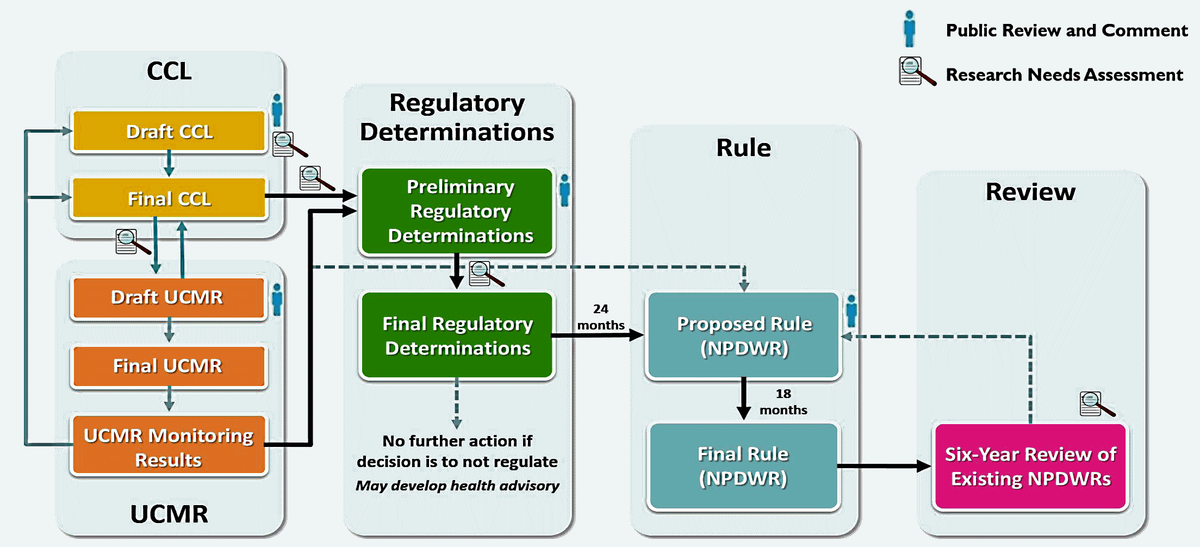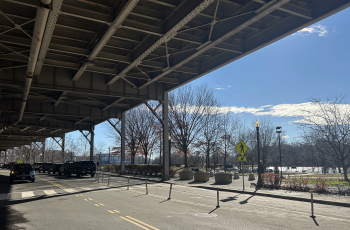What is UCMR4?
The U.S. Environmental Protection Agency (US EPA) manages the Unregulated Contaminant Monitoring Rule (UCMR) to collect data for contaminants that are suspected to be present in drinking water and do not have health-based standards set under the Safe Drinking Water Act (SDWA). Public water systems are required to survey up to 30 selected emerging compounds of concern once every five years (2018 is the fourth cycle of UCMR).
Why was the UCMR program developed?
The SDWA Amendments of 1996 provide for:
- Monitoring no more than 30 contaminants every five years
- Monitoring large systems and a representative sample of small public water systems serving less than or equal to 10,000 people
- Storing analytical results in a National Contaminant Occurrence Database (NCOD). View Occurrence Data here.
Occurrence data are collected through UCMR to support the Administrator's determination of whether to nationally regulate particular contaminants in the interest of protecting public health.
What are the public health benefits of UCMR?
The monitoring provides EPA and other interested parties with nationally representative, scientifically valid data on the occurrence of contaminants in drinking water, the number of people potentially being exposed, and an estimate of the levels of that exposure. These data can support future regulatory determinations, including initiating the process of developing a national primary drinking water regulation, along with other actions to protect public health.
UCMR4 requires utilities to monitor and submit data for:
- Nine cyanotoxins and one cyanotoxin group. Read the Cyanotoxin FAQ here.
- Three brominated haloacetic acid (HAA) disinfection byproduct group and two indicators total organic carbon (TOC) and bromide. Read HAA FAQ here.
- And 17 additional contaminants: two metals, eight pesticides plus one pesticide manufacturing byproduct; three alcohols; and three semivolative organic chemicals.
How are the contaminants for UCMR selected?
EPA reviews contaminants that have been evaluated through existing prioritization processes, including previous UCMR contaminants. Additional contaminants may be identified based on current research on occurrence and health effect risk factors. EPA further prioritizes remaining contaminants based on more extensive health effects evaluations, typically performed by the Office of Water’s Office of Science and Technology. The procedures for evaluating health effects were developed to support the ranking of contaminants for future consideration.

Courtesy of US Environmental Protection Agency
Has DC Water participated in UCMR monitoring in the past?
Yes. You might have read about things like hormones and certain medicines in the water supply having an effect on river wildlife and fish. In the water sector, these are sometimes referred to as endocrine disrupting compounds (EDCs). EDCs is the technical term for compounds that interfere with the action of natural hormones responsible for reproduction, development and behavior. Other examples include pesticides, herbicides, and natural and synthetic hormones. DC Water worked with the Washington Aqueduct and EPA, and monitored for these compounds as part of the previous UCMR cycle.
While these compounds may be detected at minute levels in water, people are regularly exposed to products containing these compounds in higher, more significant concentrations through medicines, personal care products, and food.
Emerging compounds include pharmaceuticals, personal care products and endocrine disrupting chemicals. Endocrine Disrupting Compounds (EDCs) is the technical term for compounds that interfere with the action of natural hormones responsible for reproduction, development and behavior. Examples include pesticides, herbicides and natural and synthetic hormones. Pharmaceuticals (P) are prescription and over-the-counter medications for animals and humans. Personal Care Products (PCPs) are common personal hygiene products such as lotions, fragrances and cosmetics. Together these compound are referred to as EDCs and PPCPs.



